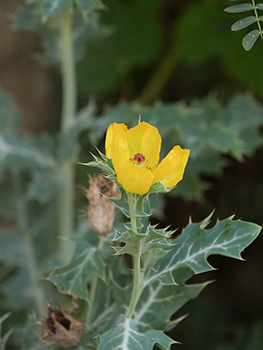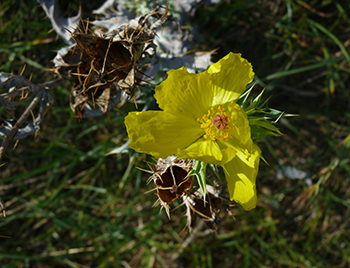
This post is also available in: Dutch (below)
A wild plant you can mainly find on places where the original vegetation is heavily disturbed is the so called Mexican poppy or Flowering thistle. It belongs to the Papaveraceae family as much as the famous red poppies do, but is originally from the New world, and especially from Mexico. It has spread all over the world and although not very common on Curaçao and Bonaire, and almost gone from Aruba, it can still be found in some locations. The debate is ongoing on the natural range of this plant and if it is native to the Caribbean or not.

The Mexican poppy survives the hardiest of circumstances with poor soil and drought easily and even continues flowering when the circumstances are really hard. Bees love the flowers of these plants but usually goats and other grazing animals will let the plant be, first because of its nasty spines and second because of its toxic features. The plant itself produces a latex-like yellowish sap that is poisonous to animals and can also be poisonous to humans. Despite this, it is used in traditional medicine in mainly Mexico. It also inhibits growth of other plants, a location with Mexican poppy will not soon be taken over by other species. Besides the plant itself the seeds are also very toxic.
English name: Mexican poppy / Flowering thistle
Papiamentu/Papiamento name: Polbo shimaron (Aruba), Chimi-chimi (Bonaire +Curaçao)
Scientific name: Argemone mexicana
Family: Papaveraceae (Poppy family)
Occurrence (ABC islands): Aruba, Bonaire and Curaçao

Wilde bloemen – de Stekelpapaver

Een wilde plant die je vooral kunt vinden op plekken waar de oorspronkelijke vegetatie ernstig verstoord is, is de zogenaamde Mexicaanse papaver of Stekelpapaver. Hij behoort tot de Papaveraceae-familie, net als de beroemde rode papavers, maar komt oorspronkelijk uit de Nieuwe Wereld, en met name uit Mexico. De plant heeft zich over de hele wereld verspreid en is niet erg algemeen op Curaçao en Bonaire en komt ook op Aruba nauwelijks meer voor. Wie weet waar ze moeten zoeken kan de plant nog wel op verschillende locaties te vinden. Er is een debat gaande over het natuurlijke verspreidingsgebied van deze plant en of hij inheems is in het Caribisch gebied of niet.
De Stekelpapaver overleeft de meest harde omstandigheden met slechte grond en droogte gemakkelijk en blijft zelfs bloeien als de omstandigheden echt moeilijk zijn. Bijen zijn dol op de bloemen van deze planten, maar meestal laten geiten en andere grazende dieren de plant met rust. Ten eerste vanwege de vervelende stekels en ten tweede vanwege de giftige eigenschappen. De plant zelf produceert een latexachtig geelachtig sap dat giftig is voor dieren en ook giftig kan zijn voor mensen. Desondanks wordt het gebruikt in de traditionele geneeskunde in voornamelijk Mexico. Het remt ook de groei van andere planten, een locatie met Stekelpapavers zal niet snel worden overgenomen door andere soorten.
Naast de plant zelf zijn ook de zaden erg giftig.

Nederlandse naam: Stekelpapaver
Papiamentse naam: Polbo shimaron (Aruba), Chimi-chimi (Bonaire+Curaçao)
Wetenschappelijke naam: Argemone mexicana
Familie: Papaveraceae (Papaverfamilie)
Voorkomen (ABC eilanden): Aruba, Bonaire en Curaçao